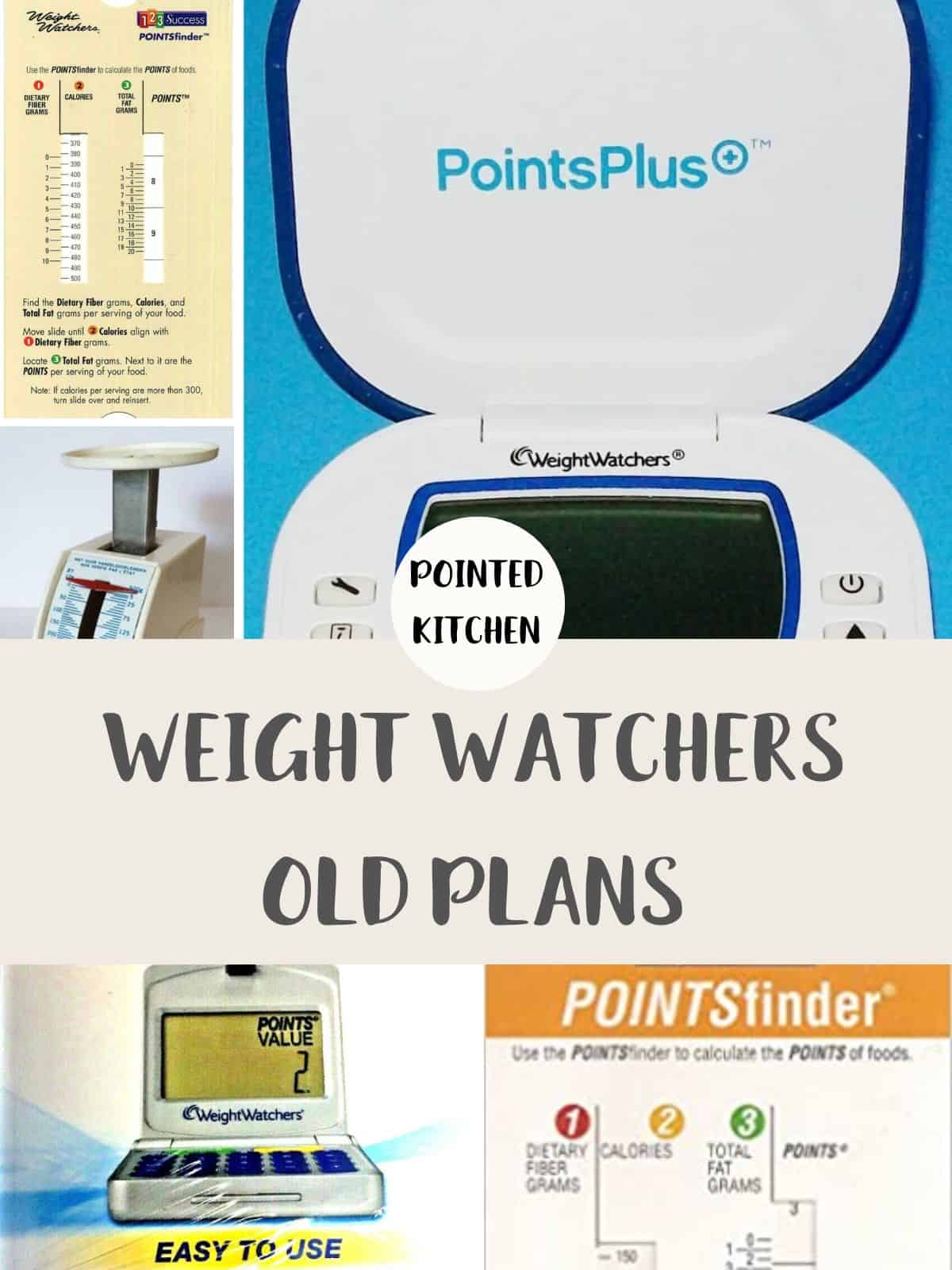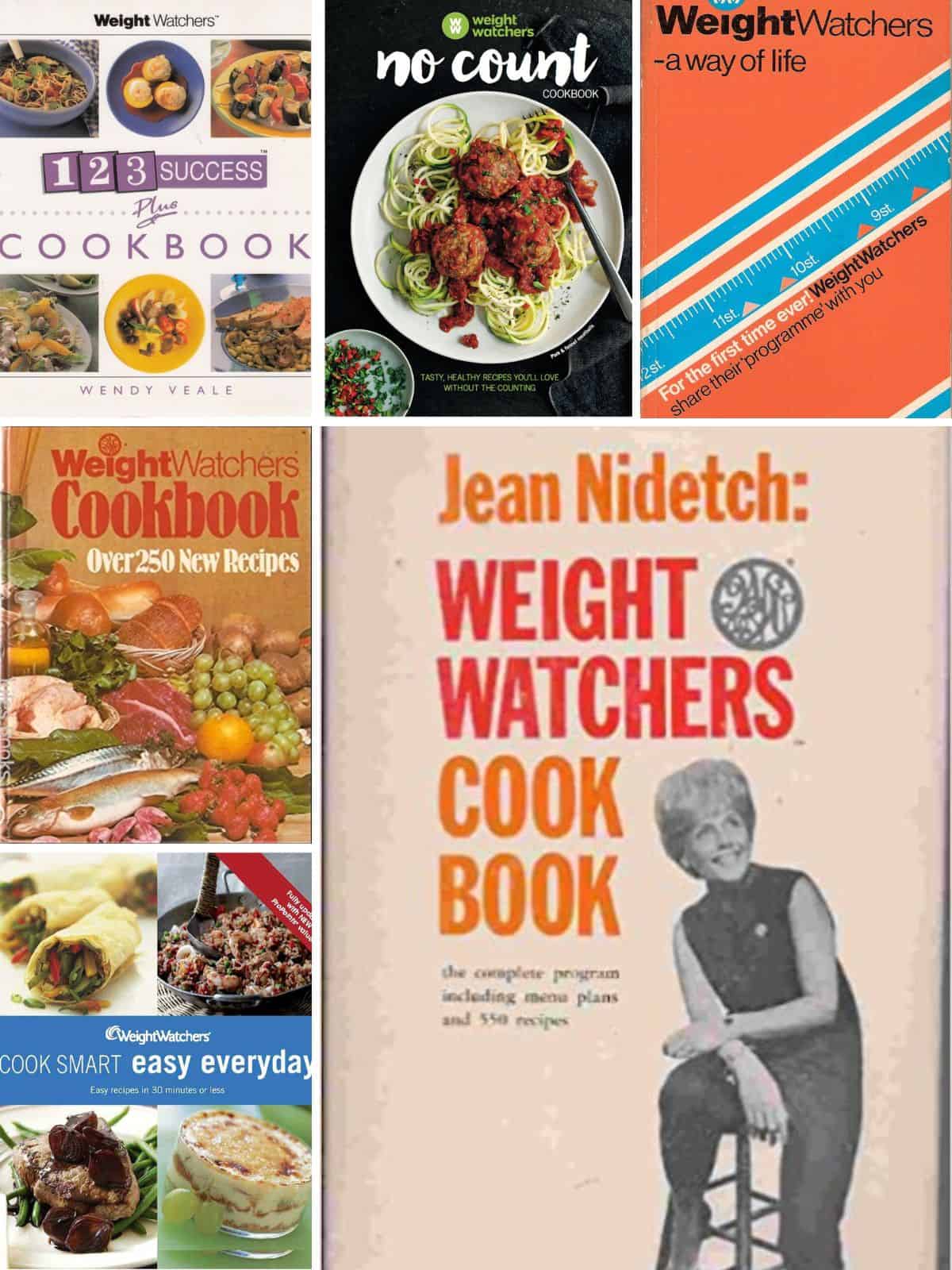Weight Watchers has, without doubt, been the leader in the weight loss industry for many decades. How many of the old Weight Watchers Plans do you remember?
Since it started in the early 1960s the program has been continuously evolving. The various plans have been adapted over the years to cater to changing nutritional science and to the lifestyle needs of its members.
I’ve taken a look at the major diet plans that Weight Watchers have introduced over the years, highlighting each plan’s key features and innovations. Which ones do you remember? Which ones did you prefer? Let me know below!

Original Weight Watchers Program
The Original Plan (1963) was based on a list of allowed and forbidden foods with strict portion control. It was created by Jean Nidetch and was based on a diet plan called the Prudent Diet, that Jean had successfully followed a few years earlier.
The prudent diet was strict. It prescribed, amongst other things, that you ate fish five times a week, liver once a week and did not drink alcohol or eat fatty foods. Although Jean lost weight on this program, it is reported that she did not like that discussion between people following the program was discouraged.
So Jean began a support group with a few of her overweight friends. She introduced the support group members to the Prudent diet and offered a weekly weigh in and they discussed the program actively. Within a couple of months her weekly support group had grown to 40 women per week.
The interest in her groups grew and grew and by 1963 Weight Watchers Inc was set up, with a weekly charge for each member. The first official meeting attracted over 400 attendees.
This Original Weight Watchers program included very strict portion control with a list of allowed and forbidden foods but it promoted community and its effectiveness in helping with weight loss.
In 1973 seventeen thousand people congregated in Madison Square Gardens in New York to celebrate Weight Watchers ten year anniversary and to hear Jean Nidetch talk. This just shows how popular the program had become!
By 1979 Weight Watchers was also promoting the importance of exercise in weight loss success. They adopted the PepStep program (which was developed by a doctor working in cardiac health) that encouraged walking and stair climbing as exercise.
In the early 1980’s the plan had expanded to include more flexibility. The program now included 3 plans - a full choice plan, a limited choice plan and a no choice plan.

Quick Start
In 1984 the Quick Start Program was introduced. There was far more flexibility in food choices and it was designed to bring about a fast initial weight loss. The emphasis on portion control remained but some free foods were included. The plan was seen as a more temporary eating plan not a way of living like it is today.
It was also the first time that foods within food categories could be exchanged for each other.
In the same year, Weight Watchers introduced the At Work Program. It allowed Weight Watcher meetings to be held in offices, for groups of 15 or more! This was a game changer for people unable to join the community meetings. Often employers subsidised the bill and the meetings were usually held in lunch breaks or before work.
In 1986, Weight Watchers introduced Quick Start Plus which allowed members to choose higher fat options in their eating plan.
Quick Success
In 1988 Weight Watchers launched the Quick Success Program. The plan was much easier and far more flexible than the plans that had come before. It was also the first time that it made allowances for people following a vegetarian diet.
Even more food options were added in 1989 with the introduction of the Personal Choice plan. Members could exchange foods in different food groups to make the plan fit their personal preferences.
1-2-3 Success Plan
In 1997 Weight Watchers completely moved away from the ‘exchange’ program and introduced the Points system.
Anyone following the WW plan now will recognise the Points system. Each food is given a Point value. In the 1990's the Point values were worked out on a food's calories, fat, and fibre content.
It was the first time that the Points system was introduced to Weight Watchers and the system was better known as the 1-2-3 Success plan.
As a Weight Watchers member around this time, you received a PointsFinder calculator slide - a nifty piece of kit! With the slider you could work out the Point value of any food by sliding the rule to indicate the amount of fibre, calories and total fat in your food. This would give you the Points value of your food.
It was now possible to work out the Points values of all foods but members were still provided with a core meal plan and it was suggested that this should be followed. The Points could only be used to exchange foods within the plan.

Winning Points
By 2000 the program had been updated and the Winning Points plan was introduced. The Winning Points plan did not include any food exclusions but highlighted the importance of behaviour modification around food. It also strongly encouraged self-observation of eating habits and promoted exercise.
The Winning Points plan was more personalised than earlier plans,
Members continued to receive a PointsFinder slider to work out Points values for foods and could use these Points on any foods they wanted. They also received a weekly paper journal that they could track their Points, their exercise etc.
It was also in the early 2000’s that Weight Watchers went online. You could track online and read about and discuss the plan on the message boards and forums.
Pure Points
The Pure Points program was introduced in 2002 which followed the basics of Winning Points but gave more flexibility to fit around lifestyle.
And two years later in 2004 the Turn Around Program was launched that gave members a choice of two plans that they could choose from. Members were still encouraged to exercise and to eat sensible portions but they could follow either the Flex Plan or the Core Plan.
As its title suggests, the Flex Plan was flexible. As long as you stayed within your Points budget you could eat anything you wanted!
The Core Plan (also know later as Simply Filling) was more rigid. Members following this plan did not count Points but instead could eat as much as they wanted from a prescribed list of foods until they felt satisfied. They were also given a list of foods to avoid.
It was around this time that the Weight Watchers program also looked at the connection between mood & food. Weight Watchers meeting leaders were given more training to help people make the connections between their eating behaviours and their feelings.
Momentum Program
In 2008 the Momentum Program was introduced and the Core plan was dropped. This new program combined elements of the Points and Core plans. Its main focus was to help members recognise that eating filling food could help prevent hunger and therefore overeating.
PointsPlus / ProPoints
In 2010 Weight Watchers went through a big(ish) program change with the introduction of PointsPlus. This plan was also know as the ProPoints plan outside of the US.
With this plan, Points were worked out on the amount of calories, fat, fibre, protein and carbohydrates that were in foods. Where previous plans had focused on the fat and fibre content of foods, this was the first plan that really took into consideration the protein and carbohydrates they contained.
Processed foods & food high in carbohydrates became higher in Points and foods with higher in protein were lower in Points. Fruits and non starchy vegetables were Zero Points allowing members to eat as many of these foods as they wanted.

Weight Watchers 360
Two years later, in 2012, the plan was adapted again and Weight Watchers 360 was launched. There were no major changes to the PointsPlus program or how Points were worked out, however in this plan more emphasis was given to behaviour modification, food planning etc.
Weight Watchers online tools were promoted and a fitness tracker called ActiveLink was available to buy for the first time. The wearable tracker tracked activity levels and automatically converted this to Activity Points.
A couple of years later the Weight Watchers 360 program included the ability to receive Personal Coaching with a certified coach via phone, text or email. Other fitness trackers, such as Fitbit, were also able to be used to track activity Points.
Beyond the Scale & SmartPoints System
Beyond the Scale was introduced in 2015. The SmartPoints system was introduced and there was a shift towards overall wellness.
A new holistic lifestyle was promoted and processed foods that contained sugar and saturated fats were further discouraged.
At the same time as the Beyond the Scale was introduced, Weight Watchers also launched Connect which became a very popular place that members could ‘connect’ with each other through the online WW system.
Freestyle
In 2016 / 2017, Weight Watchers introduced WW Freestyle (WW Flex outside the US). Over 200 Zero Point foods were included in the plan that did not need to be tracked.
Members could eat lean proteins such as chicken, non starchy vegetables and fruits without tracking them. As lean proteins were more filling they were introduced as Zero Point foods as it was thought that members were less likely to overeat them.
In this plan, members were able to carry over unused SmartPoints from their daily allowance to eat at another time.
Fit Points also became a big part of the plan. You could swap a certain number of activity earned Points for food Points.
The use of online tools and the WW App was promoted. The App allowed people to scan different foods from barcodes to discover their SmartPoint values.
myWW Program
In 2019 Weight Watchers launched the myWW program. It was still based on the SmartPoints program but three different plan options were offered - Green, Blue and Purple. Each of the coloured plans had a slightly different structure.
The Blue plan was the most like the previous WW Freestyle plan but with some additional Zero Point foods. Members following the Blue plan were given a moderate amount of SmartPoints to use on any foods that they wanted. They were also given over 200 zero Points to ‘bulk out’ their SmartPoints budget with. You can read about the Blue Plan in more detail, here.
Members following the Green Plan were given the biggest allocation of daily SmartPoints of the three plans. They were also given a list of 100 Zero Point foods. The Zero Point foods were mostly fruits and non starchy vegetables but did not include high protein foods such as chicken breast and fish. This plan was most like the original 1960's Weight Watchers plan. You can read about this plan in more detail, here.
The Purple Plan had the biggest choice of zero Point foods (over 300) but had the fewest allocation of daily SmartPoints. Zero Point foods included starchy foods such as potatoes and rice for the the first time. Read more about the Purple Plan here.

Personal Points
A few year later in 2021 the PersonalPoints program was introduced. This was a tailored program with individualized Points values and zero-point food lists. In this plan Artificial Intelligence was used to adjust each members Point allocation in accordance to their food preferences.
Members now got a very tailored set of foods they could eat for Zero Points and
extra Points were ‘earned’ for drinking water and eating non starchy vegetables.
As this Weight Watchers plan was so personalised, the community spirit of the previous Weight Watchers plans seemed to suffer. WW members were no longer following the same plan and it seems that they no longer felt that they were part of the same ‘movement’.
The change to the PersonalPoints plan also coincided with many meeting across the country being shut down and WW becoming more of an online program.
It was at this time that membership numbers in Weight Watchers started dropping.
Whether this was a direct result on the more personalised plan and the loss of community or was a result of the Pandemic is debatable.
Points
One year later in 2022 the Points Program was introduced.
It was a simplified plan (compared to the Personal Points plan) and is similar to the Freestyle program and the Blue plan of the myWW program. Members were given the same list of over 200 Zero Point foods and a set amount of Daily & Weekly Points (based of their weight, sex, height etc) that they could used on whatever foods they wanted.
Whether the swap back to a less personalised plan was in response to the disquiet in the WW community with the PersonalPoints plan is open to discussion!
The Future of Weight Watchers
For years & years, Weight Watchers has made minor changes to its plans on a yearly basis and bigger changes every two years.
It has now been a year since WW changed from the Pesonal Points Plan to the Points Plan. It remains to be seen whether they stick with the Points Plan through 2025 or whether they make more changes to it.
The future of Weight Watchers also sadly remains to be seen!
Personally, I really hope that it continues to help people on their weight loss journeys for many years to come, with plans that continue to promote community and support from other members.

Leave a comment!